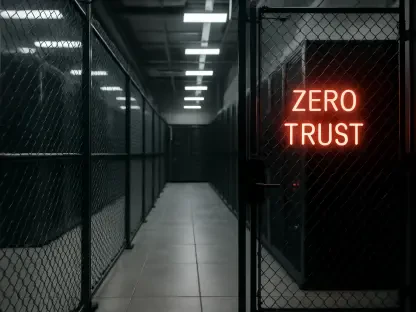The recent SharePoint cyberattack has marked a significant turning point in the cybersecurity landscape, sparking an urgent reevaluation of security measures across industries and sectors. This event, noted for its exploitation of zero-day vulnerabilities, unraveled major security weaknesses in legacy on-premises infrastructures and highlighted the pressing need for innovative security approaches. The impact extends beyond immediate repercussions, signaling a paradigm shift toward advanced, AI-driven, and cloud-native solutions to safeguard systems against increasingly sophisticated threats.
Revealed Vulnerabilities and Industry Impact
Understanding the Depth of the Breach
The incident, primarily linked to hacker groups such as Linen Typhoon and Storm-2603, exploited two critical zero-day vulnerabilities that highlighted serious deficiencies within unpatched and outdated SharePoint servers. These vulnerabilities allowed unauthorized access to internal systems, leading to the theft of sensitive cryptographic keys along with the deployment of disruptive ransomware. Many companies reliant on legacy systems faced significant risks, underscoring the need for timely updates and better maintenance practices to defend against such breaches. The vulnerability of these systems underscores a critical lesson: the security landscape is drastically evolving, and tenacity in updating defensive measures is no longer merely advisable but essential.
Financial Repercussions for Tech Firms
Significant financial implications followed in the aftermath, exemplified by a tangible drop in the stock value of major tech firms, particularly Microsoft, which experienced a 4% decline. This decrease reflected acute investor concerns regarding delays in addressing known vulnerabilities and communicated the broader need for robust, future-focused security strategies. Such events emphasize recurring vulnerabilities within large tech infrastructures, reminiscent of previous major breaches like the 2023 compromise of U.S. governmental communications. These incidents have collectively highlighted systemic flaws, prompting a necessary shift toward more resilient, less vulnerable security approaches to maintain stakeholder trust and secure infrastructure integrity.
Opportunities and Innovations in Cybersecurity
Rise of AI-Driven Solutions
While the breach illustrated the vulnerabilities within outdated systems, it simultaneously catalyzed growth within the cybersecurity sector, particularly for companies championing advanced security technologies. Organizations specializing in AI-centric solutions, such as CrowdStrike and Palo Alto Networks, have seen considerable upticks in their market valuations. This rise can be attributed to their strong capabilities in offering real-time threat analysis and effective management of hybrid security infrastructures. CrowdStrike’s Falcon platform, known for its real-time analytics, and Palo Alto’s Prisma SASE and Cortex XSIAM platforms have been instrumental in showcasing how cutting-edge AI tools can deliver dynamic security solutions to complex environments.
Increased Demand for Identity Governance
The attack’s focus on authentication flaws has intensified interest in identity governance, spotlighting how secure access solutions align with evolving security models like zero-trust. Companies such as Okta and Cloudflare have emerged as pivotal players in providing continuous verification processes rather than traditional perimeter defenses. This zero-trust architecture has positioned these companies well within the market, reflecting the growing adoption of models that prioritize secure identity management and constant authorization verification. As enterprises transition from perimeter-based systems to identity-centric frameworks, these models are becoming integral to their security strategies, responding adaptively to a more sophisticated threat landscape.
Emerging Industry Trends and Strategic Shifts
Transitioning to AI and Cloud-First Security
The ramifications of the SharePoint attack highlight a broader trend towards the integration of AI in enterprise security systems. AI’s role is becoming increasingly central to strategies designed to provide extended detection and response capabilities. There’s a growing consensus that AI-driven security solutions are not just beneficial but necessary to effectively counter modern cybersecurity threats. This evolution emphasizes a shift from traditional, perimeter-focused defenses to more robust, identity-centric, and cloud-native security architectures. With industry leaders like Palo Alto spearheading this pivot, the shift underscores the importance of adopting continuous verification models that accommodate fast-evolving technology landscapes and emerging security challenges.
Urgency of Moving Away from Legacy Systems
Awareness of inherent risks associated with maintaining legacy systems has gained significant traction, urging a push toward cloud-native strategies. The industry is witnessing a concerted move to replace outdated infrastructures with agile, scalable, and intrinsically secure solutions. Companies are increasingly investing in enhancing their security architectures, exemplifying a wider industry acknowledgment of the advantage cloud-first approaches offer over traditional models. Embracing this transformation is becoming not just a recommended strategy but a critical necessity for organizations aiming to maintain secure, resilient, and efficient operations in the face of unrelenting cyber threats.
Strategic Outlook and Future Considerations
The recent cyberattack on SharePoint has become a landmark event in the world of cybersecurity, prompting a critical reassessment of security strategies across various industries and sectors. This incident, particularly noteworthy for its use of zero-day vulnerabilities, has exposed considerable security flaws in outdated, traditional on-premises systems. These revelations underscore the urgent necessity for developing innovative security methods. The consequences of this attack reach far beyond its immediate effects, pointing towards a significant shift in security paradigms. As threats become more sophisticated and persistent, there is a growing need to adopt advanced security solutions, particularly those that are AI-driven and cloud-native, to protect digital infrastructures effectively. This evolution in threat management underscores the importance of moving away from legacy systems and adopting cutting-edge technologies that can anticipate and mitigate future attacks, ensuring robust cybersecurity frameworks for organizations worldwide.









